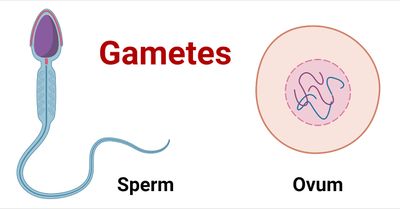Gamete: Difference between revisions
From Future Worlds Center Wiki
Jump to navigationJump to search
(added how many gametes in male/female reproductive cell) |
No edit summary |
||
| (3 intermediate revisions by the same user not shown) | |||
| Line 1: | Line 1: | ||
A '''gamete''' is a reproductive cell of an animal or plant | A '''gamete''' is a reproductive cell of an animal or plant. | ||
In the male, the production of mature sperm cells, or spermatogenesis, results in four haploid gametes, whereas, in the female, the production of a mature egg cell, oogenesis, results in just one mature gamete. | [[File: Gamete.jpeg|400px]] | ||
In animals, female gametes are called [[Ova|ova]] or egg cells, and male gametes are called [[Sperm|sperm]]. Ova and sperm are [[Haploid|haploid]] cells, each carrying only one copy of each chromosome. During fertilization, a sperm and ovum unite to form a new [[Diploid|diploid]] organism. When the gametes join, they form a cell called a [[Zygote|zygote]]. | |||
Human sperm and eggs contain 23 chromosomes. Human zygotes contain 46 chromosomes. | |||
In the male, the production of mature sperm cells, or [[Spermatogenesis|spermatogenesis]], results in four haploid gametes, whereas, in the female, the production of a mature egg cell, [[Oogenesis|oogenesis]], results in just one mature gamete. | |||
[[Category: G-Definitions]] | [[Category: G-Definitions]] | ||
Latest revision as of 01:09, 28 January 2023
A gamete is a reproductive cell of an animal or plant.
In animals, female gametes are called ova or egg cells, and male gametes are called sperm. Ova and sperm are haploid cells, each carrying only one copy of each chromosome. During fertilization, a sperm and ovum unite to form a new diploid organism. When the gametes join, they form a cell called a zygote.
Human sperm and eggs contain 23 chromosomes. Human zygotes contain 46 chromosomes.
In the male, the production of mature sperm cells, or spermatogenesis, results in four haploid gametes, whereas, in the female, the production of a mature egg cell, oogenesis, results in just one mature gamete.
